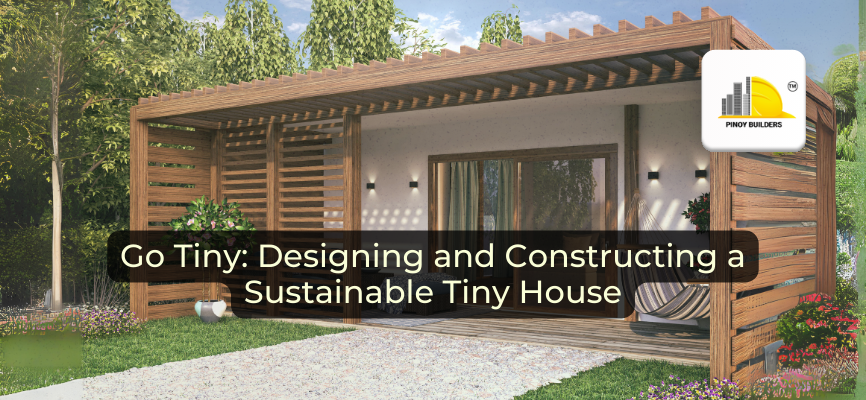While a tiny house is usually 36sqm or less of living space, there’s a lot more to it.
Photo from Pexels
It’s a way to save money, live more simply, and for some, a way to enjoy the comforts of home without being tied down to one place.
The Tiny House ‘movement’, as we know it, began in the United States in response to a sequence of events that rocked the housing market. Homelessness among young people increased because of the downfall of the economy and natural calamities such as hurricane Katrina. The demand for low-cost and flexible housing increased, so some people started building their own tiny homes.
To this day, the “tiny house movement” is in every corner of the world. In the Philippines, young architects, designers, and people in the tourism business are seeing the appeal of stylish, small, modular, living spaces and rental spaces that are both small and stylish.
RELATED: Can You Build A House in a Day? Check Out Slater Young’s Latest Innovation!
Aesthetics
Over the last decade, people have become more interested in living a minimalist lifestyle because of its low costs and environmental impact, as well as because its aesthetic architecture design appeals.
1. Wood
Photo from Aesthetics of Design
To give the illusion of more space, many tiny houses have wood paneling and enormous windows. Compared to the plastic or metal exteriors of camper vans and trailers, the wood exterior is appealing and stylish. The roofs of most tiny homes are pitched and have overhangs for practical reasons as well as to keep a little of tradition in them. The wooden exterior fits in to care for the environment.
2. Storage and Space
Many of these homes show how clever storage and multi-functional furniture can make the most of limited space, bright interiors, and modern finishes.
Some of the most common features of tiny homes are the main loft for the bedroom, a fully equipped kitchen, a stackable washer and dryer, a full bathroom with a tub, and areas that works for both dining and relaxing.
3. Sustainability
A lot of the features of sustainability for tiny homes include photovoltaic systems that use solar energy, rainwater harvesting and recycling, and energy-efficient designs.
RELATED: How a Filipino Startup is Making Waves with Sustainable Housing
Tiny House Must-Haves
Aside from facilities for eating, sleeping, washing, and living, here are some things that your tiny house must have.
Minimum height ceiling. To be considered a habitable living area, the ceiling height must be at least 2 meters, while 1.95 meters can work for bathrooms and kitchens.
Windows. A tiny house doesn’t have to have a certain number of windows, but it has to have enough emergency exits to get out in case of an accident.
Stairs. Tiny homes can have stairs, like ladders, ship ladders, or other ways for people to get to the loft.
Toilet/Bathroom. A tiny house should have at least one separate bathroom.
Sink and Food Preparation Area. Independent living is very important in the tiny house concept. It is important that people have an area to prepare and cook. You can also have a combination of kitchen and dining room.
Sleeping Area. Sleep is a necessary part of life. For tiny houses, the majority has a loft as their sleeping space. Loft Beds are space-savers and therapeutic!
How To Design a Tiny House?
Before you can ever live in a tiny house, you need to plan it out. Here are some architectural design tips that you can apply for designing your own tiny house.
1. Keep things clear above the waist.
The kitchen may be an exception, but it’s usually a good idea to keep “clutter” below your waist level in your tiny house to get a better sense of space. You’ll be able to move around without having your shoulders and arms hit things all the time.
2. Opt for a high ceiling.
Shed, gable, or any other ceiling that goes all the way up will make any tiny house feel a lot bigger. It will also give you more space to put in windows and let in natural light, which will save you money and make your home look better.
3. More windows.
Windows not only let in natural light, but they also give the illusion of space and lightness to a room or building. Natural light is also sustainable.
4. Make multi-purpose areas.
You might have a couch area where you can relax during the day or work on your computer while you’re sitting there, too, and might turn it into a bed at night.
With a kitchen table that folds into the wall, you could also have another area where the seats can turn into a guest bed with removable cushions to make more space for storage.
5. Avoid partitions.
Get rid of any unnecessary wall partitions. It’s a way to get more out of your space.
RELATED: Small Living Room Design Ideas for You Next Home Renovation Project
Small House Design Ideas
Small house designs in the Philippines are becoming more and more popular in today’s modern world. Many of us recognize that living in a cozy, tiny house is more convenient, sensible, and environmentally beneficial in today’s climate. They aren’t just applauded for how well they work and how minimalist they look, but they also get a lot of attention for their sustainability and green design.
Choosing to live in a small home gives you the freedom to decorate and personalize your space anyway you see fit. You’d be surprised at how many creative and practical ways there are to organize and display the memories and keepsakes you collect in your house.
With this, we hope to provide you with some small house design inspiration for plans and projects!
1. Two Story Small House Design
Two story small house designs in the Philippines are environmentally beneficial since they have a smaller footprint and hence put less stress on the environment. They are both cost-effective and easier to construct.
Photo Courtesy: The Architecture Designs
2. One Bedroom House
This 3×6 meters two story tiny house design has a total floor area of 28sqm and a small balcony on the first floor. You can have one bedroom on the first floor and an open living space with a bathroom/laundry room on the ground floor.
Photo from House Design Ideas
3. Modern Small House Design
This modern house design is an excellent take on modernism, complete with unique details that make it a truly unique space.
Photo from Architectural Digest
4. The Tropic House
This house design has an area of 5x20m. It is possible to divide the small house’s interior design into manageable sections by cleverly using the space.
Photo from Archello
5. Modern Exterior Look
This house design is a 25sqm one-story house that can fit one bedroom and one bathroom.
Photo from SH Design
Possible Cost to Build a Small House
Checkout this tiny house plan designs from BEP Designs you may build for roughly Php150,000 to Php350,000!
1. Mediterranean Small House Design for Php 150,000 (7 x 6 meters)
Screen Capture from BEP Designs
Screen Capture from BEP Designs
Screen Capture from BEP Designs
Watch the full tiny house design plan below:
2. Elevated Flood Roof Bahay Kubo for Php 350,000 (42sq. m.)
Screen Capture from BEP Designs
Screen Capture from BEP Designs
Screen Capture from BEP Designs
Watch the full tiny house design plan below:
Small houses are an excellent option for any generation as they allow for a more free, simple, and inexpensive living, as well as a chance to create a truly one-of-a-kind home that everyone can be proud of.
Subscribe now to see more content like this in the future!
CITATIONS:
- Why do so many generations like tiny homes? (n.d.). Eco Tiny House. Retrieved February 4, 2022, from https://ecotiny.house/blog/tiny-homes-generations
- POPULAR 2 STORY SMALL HOUSE DESIGNS IN THE PHILIPPINES. (2018, July 16). The Architecture Designs. Retrieved February 4, 2022, from https://thearchitecturedesigns.com/popular-2-story-small-house-designs-in-the-philippines/
- Jones, L. (2020, July 28). Inside a Melbourne Home That’s a Modern Twist on a Cuckoo Clock. Architectural Digest. Retrieved February 4, 2022, from https://www.architecturaldigest.com/story/inside-a-melbourne-home-thats-a-modern-twist-on-a-cuckoo-clock/amp?epik=dj0yJnU9cDhYOFdTbUw1azFRT1lobEFVLWRoSThaUl81b0dDancmcD0wJm49Y1dfWU9XVGRyOExBYWVMRlIwQTJxUSZ0PUFBQUFBR0g2QTJj
- RISOU. (n.d.). CULTURE OF LIVING FOR MULTIPLE GENERATIONS IN THE SAME HOUSE. Archello. Retrieved February 4, 2022, from https://archello.com/project/the-tropic-house
![]()










